We are a small group of amateur naturalists committed to merging ecology and spirituality. For twelve winters we have traveled to the coast to witness the arrival of a hundred thousand tundra swans and snow geese to their wintering grounds at the Pocosin Lakes and Mattamuskeet National Wildlife Refuges. On this January weekend we hope to finally be able to express our response to these captivating experiences that mostly leave us speechless.
How to respond? More than any other encounter in nature, the sublime sights and sounds of these migratory swans and geese arouse in us a desire to worship, yet we have not been able to find an adequate way to do so. With our wild bodies we desire to meet the awesome wildness of these birds and the bears and otters and eagles who share these lakes, woods, and pocosins. Pocosin is the Algonquin name for the vast peat-filled evergreen shrub bogs of the Albemarle Peninsula.
Here on these refuges there is a magnificent abundance, a taste of older times, yet not so long ago, when animals far outnumbered people and surrounded us on their land. Our lives have become almost obsessively people-centered. Perhaps we are trying to fill the great hole that is our loneliness for other species, other kin.
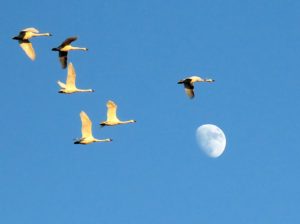
Is it we who pilgrimage to see these beautiful birds? Really it is they who are the travelers, making the two thousand mile annual pilgrimage to this family celebration of warmth and light. Huge flocks of tundra swans and snow geese undertake the long journey each winter from the Arctic coastal tundra to the marshes and estuaries of the North Carolina coast. Destruction of southern wetlands has reduced their former food sources in these wintering areas, but they have adapted to feeding on surplus grain in agricultural fields at the refuges. They spend their nights sleeping safely on lakes and inland waters. Swans and geese mate for life and migrate in close family groups, whooing and cackling constantly to keep their relatives together.
The refuges are called sanctuaries, areas for resting and feeding. Sanctuary means ‘a safe place’ or ‘a holy place.’ Thankfully, we designate safe havens, but will we ever protect and entitle natural areas as sacred land, rather, re-sacralized land? What if this landscape were a vision of hallowed ground as it was for the Native American ancestors of this place? Can you imagine hearing that the United States has protected and consecrated the first ever wildlife preserve? Indian nations are beginning to create national parks to protect biodiversity, and they will, no doubt, emphasize the sacredness of the land.
Our Native American brothers and sisters are finally coming out from under the yoke of colonial oppression to stand up and speak out strongly for the land and waters and animals as sacred. But there are no intact tribes left out here on our coast to hold the black bears sacred, as many Western tribes hold the grizzly, or to hold tundra swans sacred as the Navaho do. The Algonquin-speaking people who lived here were some of the first to be wiped out. The Machapunga lived in this Pungo River area. Many lived in a village called Mattamuskeet. Although drained down to only one third its former vast size, Lake Mattamuskeet is still the largest natural lake in North Carolina. The huge rafts of brilliant whiteness of swans and geese on the ethereal blue waters of Pungo Lake and Mattamuskeet evoke visions of holy peace.
What can we do, our group asks, to open our hearts, our senses, our intuition, to receive messages from the spirits of the swans, the spirits of the land? What can we do to honor them, send blessings to them, and give our love to them?
For 500,000 years humans have lived with wild animals, granted not always safely, but always meaningfully. We strengthened these relationships and endowed these encounters with mythic stories.
In the United States we are eliminating wild animal habitat by thousands of acres every day, but we still have a great amount and diversity of wildlife, unlike Western Europe, say, where brown bears were already extinct by the eleventh century. In the midst of the current extinction crisis we need to know that our iconic animals have not all disappeared. We need to retain hope and actively support the conservation of large natural lands for them to live their rightful lives.
The first time we went out to Pocosin Lakes NWR was January of 2008. Trying to find Pungo Lake, we drove past huge rich, black fields and sparsely spaced houses for what seemed like ages before we saw a small sign for the lake. Beyond that, there was just a long muddy road that finally dead-ended. We were about to give up when we saw a woman standing beside a parked vehicle at a gate and asked her if she knew where the lake was. She said yes, so we hurried along a dirt track between cornfields and woods to catch up with the three other women ahead.
Meanwhile thousands of snow geese, swans, and migratory Canada geese started arriving, circling, landing, each in their distinctive patterns of descent. Again and again groups of the white birds would rise up and circle the blue sky and land in the yellow field. The woman, Stacy, said if we were quiet we might see bears on the way back. We walked about a mile while a billion (at least!) red-winged blackbirds passed through in a long, continuous sideways tornado. The swarm appeared as a smudge as far away on the horizon as we could see. The throng of blackbirds kept passing over the cornfield between us and the white congregations of birds, soaring gracefully over the trees, continuing south. This great passage of blackbirds down the coast is another spectacular migration to be witnessed with astonishment.
We cut into the forest of tall trees and cane and walked to the muddy edge of Pungo Lake while Stacy stayed back, keeping watch, on the track. Snow geese and tundra swans were hunkered down in the shallows to the left, and we could see a hundred others arriving across the lake. We had seen bear tracks on the trail, but here were fresh tracks of two bears who had gone out to the water to drink. Stacy came up behind us and whispered, “A bear!” We hurried back out on to the track and saw a large black bear hunkered down in the cornfield.
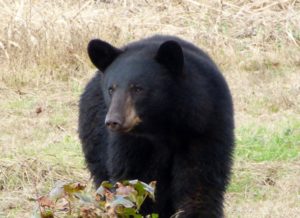
As we watched, the bear got up and moved slowly toward the track, waded the ditch, and climbed up the bank onto the dirt track. Two smaller bears came out from the woods and joined it, and they all began walking down the track. “How cute. They’re strolling down the path just like we are!” we said. Then we realize they’re coming towards us! It’s quite dusky by now, but we can see the mother and her yearling cubs getting closer and closer. “What’s Plan B?” I whisper, getting a little scared, as is one of the other women. But the two oldest women are steadfast. They are scientists. They’ve done this before, and they want pictures and the experience of this encounter. Finally, the bears turn and go into the cane. Whew. We continue walking gingerly past the place where they had entered. But someone turns and says, “They’re behind us!” After glancing back nervously, we are relieved to see that the bears have crossed back into the cornfield. We left the multitude of geese and swans squawking and honking as dark descended.
It so happened that, back home the next morning, I attended an Authentic Movement session. As soon as I stepped out on the floor, I felt an immediate urge to fall to my knees and praise the earth and thank the heavens for the magnificence we’ve been given. I danced the way I had felt in the field with the bears that I couldn’t express in the reserved company of the naturalist group. There was a huge outpouring of the awe and amazement I had felt. Resistances dissolved, that I didn’t even know I had, as I surrendered to this . . . this revelation of glory!
On another of our yearly trips to Pungo Lake we saw huge numbers of red-winged blackbirds in the grain fields on the way into the refuge. Three marsh hawks were swooping. We didn’t realize how related these events were until we got to the lake and saw at least five bald eagles, several marsh hawks, a red tailed hawk, and a horde of red-wings eating in the cornfield, periodically rising in unison. The red epaulets of a hundred blackbirds lay scattered along the track.
Cutting through the cane at the lake we saw a huge raft of snow geese lift off and wheel in a formation that kept turning black against the sun, then white facing it. Then the flock flew noisily over to the fields, circling and landing a hundred or so at each pass, becoming invisible, perhaps hiding themselves, among the swans. As the hawks and eagles would swoop, snow geese would rise up in a white cloud and whirl. Red-wings would rise up in a black cloud and swirl, while the swans would just stand there sedately, unperturbed and unmoved.
When we were almost back to our cars, someone yelled, “Bear, bear!” We turned to see a large bear weaving back and forth across the track we had just left. Our final picture was of the bear below, two eagles in a tree above the bear, hawks swooping and red-wings rising, and all the snow geese up, flying back to the lake. We’re thinking, “Yeah, right, this is an impossible conjunction of animals like you’d see in a museum diorama, not in real life!”
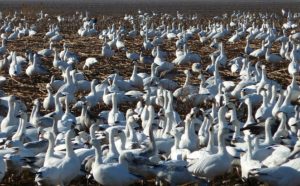
On an especially cold winter visit when we arrived at the Pungo Lake fields we found a hundred photographers with huge long lenses lined up, some on their bellies, clicking away. There were more snow geese here in one place than anyone could ever remember. The word had gotten out. Later, recalling those passionate photographers, and us taking pictures, too, I began wondering: Was the line crossed at all between us people over here and those birds over there? Did the birds get under people’s skin? Were people affected by the birds, emotionally, relationally, or spiritually? Did any of us participate in the life of those birds just a little bit? Did we become a tad more birdlike? Did we lose our separate egos in some kind of bird-human combination for even just a few seconds?
I wondered who among us learned something about ourselves through the birds that we never knew before. Did we become animal as we surely are? This is urgent to me, because unless we identify as part of nature I don’t see how we will be able to protect Us. Did we join in kinship? Did we join in soul? Were people crying behind those lenses?
Now, on this January weekend, our plan is to stay in the small town of Plymouth, home of the Black Bear Festival, spend our early mornings at Lake Phelps and our days and evenings at Pungo. Then on Sunday afternoon we hope to co-create a ceremony in which we finally make, after all these years, what feels like an adequate expression of our love for this place, which has affected us all so deeply.
Friday night our group arrived at Pungo in time to see a couple of bears eating left-over corn in the field. They especially like to come out in the evening. As the sun set we watched the field and the trees beyond turn first golden and then pink; the swans flying in little groups overhead changing colors from gold to pink as well. Ten or more groups of ten or more fast flying wood ducks crossed over from the direction of the impoundments to the lake. After sunset bats flitted about in the deep rose glow. Leaving, we stopped on the refuge road to watch as tens of thousands of snow geese began arriving from the fields to spend the night at the lake. The long lines of birds weaved gracefully through each other, each line of birds passing through another line exactly like chorus girls, bird by bird, and smoothly continuing their line on the other side.
Saturday morning we left our motel at six to watch the seven a.m. sunrise at Lake Phelps, the second largest lake after Mattamuskeet. We arrived to find an incredibly gorgeous scene of red sky and water burning like lava. Before us were many thousands of swans still sleeping, black in silhouette, back-lit by the molten colors. Then the sunrise split the horizon into brilliant golden bands, and all the Spanish moss-draped cypress trees on the shore behind us lit up in gold. Such radiance!
Farther down the lakeshore we climbed the wooden observation tower at Pocosin Overlook, noticing bears’ claw marks on the steps. Back down, we’re standing on the landing at the water’s edge when I notice movement in the water out beyond a row of small bonsai cypresses lining the edge. Whoa, could that be . . ? Otters”! I exclaimed as they dove playfully through the little cypresses, coming closer. Then, spotting us, one by one the three of them popped up and stared. They dove under, then bobbed up again a little farther away, looking at us, curious about our presence. Then they disappeared, but not before all three popped up again for one more look.
As we drove toward Pungo we stopped often to watch short lines of swans on their arrow-straight missions crisscrossing the skies. Flying low above the flat, quiet landscape of vast yellow grain fields they made a very serene scene. Tundra swans are venerated for their elegance in flight. I loved the times when we would fall silent, just listening to them call to each other, and hearing their huge wing beats, whoosh, whoosh, as they passed right over our heads.
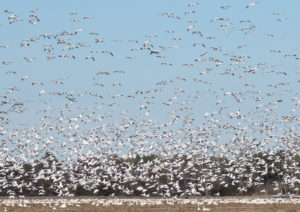
When we arrived at Pungo there were thousands of swans in the field at the entrance. We searched but couldn’t detect any snow geese. Suddenly, with an explosion of wings and cackles, the snow geese rose en mass, making amazing white shapes that morphed and twisted in the blue sky. The swans were unimpressed. The rising and whirling of the snow geese formation happened again and again. Each time, their white bodies turned the dark pine trees white as they came drifting back down like large flakes in a very heavy snowstorm. Incredibly fast vortices of thousands of red-wings, spiraling along the ground, would rise up periodically in storms of black against the clouds of white, then dropping back down, without missing a single beat, would resume their inconceivably fast clockwise gyre.
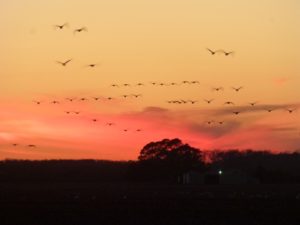
Saturday Night. We had seen several black bears during the day, including the little one who stayed on one side of the water-filled ditch while the mother kept coming back from the cornfield, first to encourage, then to cajole him to come over to her. Finally he slid down the muddy bank and paddled across. Our group settled in to witness a colorful sunset and a dramatic red dusk. Scanning the sky, we began to see long, sinewy skeins of tundra swans coming in from where the sun had set. Invisible in the distance, we estimate fifty thousand swans arriving in long threads that look for all the world like lines of snow geese except that each line stays separate. And as they get closer we can see that they form loose, but definite V’s, not weaving through each other like the dancing geese. Passing right overhead, a cacophony of whooing fills the night sky.
Sunday morning we again arrive at Lake Phelps before sunrise. Walking out on the dock, we can see nothing but white in front of us. It’s the noisiest nothingness imaginable. The whooing of thousands of swans, loud enough to surely be visible, is accompanied by the maniacal laughter of ducks. A loon calls. Another loon answers in the distance opposite. The twitter of a kingfisher crosses the blank page before us like a line of unwritten music.
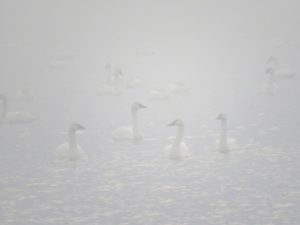
Gradually the first white-on-white shapes emerge as ghostly long-necked apparitions. As the sky lightens the scene seems even more surreal. The birds that had been so invisible materialize so close. Filled with wonder, we see that swans cover the lake from east to west. If we hadn’t risen early to come to the lake at that bothersome hour we would have missed this perhaps never before seen conjunction of light and water and birds. As the fog rises up from the lake the moon-like sun makes a luminous path of white through the pale grey water. We watch the loons, along with some buffleheads and hooded mergansers, diving, disappearing here and reappearing elsewhere. How often it’s been this way. Just when things seem ordinary, magic appears. Here on the refuges nothing can be expected or predicted. Every moment brings a different wild surprise. We feel like children, when everything was enchanted.
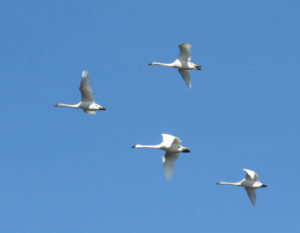
Sunday Afternoon. Having experienced this glorious abundance, we meet together this afternoon to ask how we can respond to this splendor. Having heard the voices of the swans, what have we heard them saying? What are the ways we can express our reply?
We want to make a ceremony to honor and celebrate this white-hot intensity of life. We begin by saying what we each have found most alluring, speaking words of appreciation, our intention being to reflect the beauty of the land back to itself as these waters and animals have reflected our wild souls back to us. We make offerings of gratitude to the Spirit that infuses all.
Joan, the historian in our group, recounts the story of how these extensive pocosin wetlands were saved from destruction by a huge peat mining operation and how the swans and snow geese, once hunted to near extinction for their feathers and their flesh, have returned to these protected lands. She commends the courage of all the people who fought for years against the Navy’s proposed Outlying Landing Field. Their plan had been to make the swans and geese leave so that jets could practice continuous take-offs and landings, turning thirty thousand acres of cropland and pocosin into a giant aircraft carrier.
Our fiercely committed activist friend, Lizzy, tells us of the Lumbee, Halima-Saponi, and Coharie tribes’ current fight against the Atlantic Coast Pipeline which would cross the tributaries of their rivers. In solidarity we acknowledge the still-pervasive disregard for our indigenous peoples and their attachments to their sacred lands and waters.
The group’s mythologist and storyteller, Declan, looking quintessentially Irish with his raven black hair and pale skin, tells us the beloved Irish myth of The Children of Lir, who, greatly loved by their father, King Lir, were turned by an evil sorceress into swans. They sang their plaintive songs with human voices for nine hundred years. “The music calmed and delighted all who heard it.” At that time it was proclaimed that no swan should ever be killed in Ireland, and to this day they are fully protected. Then Declan weaves a tale of times when bears and swans might also have been persons in the myths of this land. We envision creating new stories of our relationships to these animals. “Myth is the power of a place speaking,” says Martin Shaw.
My contribution is to help us respond emotionally through movement, so as to fully express our wild feelings of awe or joy or sadness. Through “somatic empathy,” we move with the bears and as the swans, remembering peoples who were so identified with birds that they danced themselves into their own bird bodies to become more themselves.
Wiry, energetic songwriter, Cynthia, sings Wild Swans [1], a song about swans in winter snow. Joining closer in a circle we all sing the chorus.
And the snow falls on our shoulders
Like the snow white wings of a swan,
Softly she falls like an angel,
Enfolds us as one of her own.
Red-haired Maisie reads a poem by Judith Willson called the Swan Bone Flute.[2]
. . . The swans lift their necks,
open the great doors of their wings. Our faces are fading
behind our white breath; a flute’s seven feathery notes
still dissolving on the air. Mothers or sisters
walking towards us, hold out their hands.
They will sit with us, watch the hours swing round,
skeins streaming north. Soon the year’s sharp light
will sing in the bone. . .
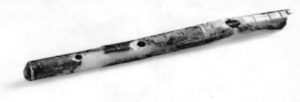
David passes around a photograph of a 37,000 year old Paleolithic flute made from the radius bone of a swan. He turns up the volume on an evocative recording of poignant, haunting music played on a replica of that swan bone flute.[3] As swans cross the skies overhead calling to each other.
Perhaps it is the sound of the swan bone flute that calls to the ancestors. Dignified elders and sleek young men, mothers and sisters carrying babies, can be seen appearing out of the distant mist, like the swans on that white morning. Wearing deer and bear skins, beads and earrings of carved white shells, and the feathers of swans and eagles, they approach from the direction of the ancient village of Mattamuskeet.
From the north come farmers and boys wearing felt hats, buckskin breeches and jerkins. Women and girls clothed in thick cotton dresses and hooded coats of hide arrive with tousle-haired children in tow. These are the ancestors of the English settlers who had taken over the land, summoned by our grief and praise, and somehow remembering in their blood and bones a genetic bond with an ancient homeland of bears and swans.
Descendants of these tribal people and of the settlers also arrive, holding out their hands, to join in a ceremony of reconciliation and renewal, to heal the wounds of their animosity, and to celebrate their belonging to the spirit of a shared land, to a shared community of life.
Together the elders evoke a vision of embracing our roles as co-creators in the material and spiritual evolution of the Earth. The old stories may be gone, but this is the story this land is telling us now, a true story that whoever loves the land belongs to all the beings of the land. We name our new and timeless union the People of the Swans.
Text ©2020 Betty Lou Chaika, Photos ©2020 Betty Lou and David Chaika, except for Paleolithic flute.
Mariah Wheeler
What enchantment, Betty Lou! I loved every word, every experience, every image, as if I were there with you. My favorite part was this imagining: “Did the birds get under people’s skin? Were people affected by the birds, relationally or emotionally or spiritually? Did any of us participate in the life of those birds just a little bit? Did we become a tad more birdlike? Did we lose our separate egos in some kind of bird-human combination for even just a few seconds?” It was obvious that the birds did get under your skin. I want to hear more about this . . .
Betty Lou Chaika
Thanks, Mariah, for your enthusiasm. I’m happy to imagine you with us and the swans! I also appreciate your telling me what you liked most; good feedback. Each person has their own way through which they let a meaningful encounter get under their skin: through seeing, hearing, touching and many other sensory pathways. Mine seems to be kinesthetic. I have to move or dance with some being or experience in order to really respond emotionally, relationally, spiritually. Perhaps your way of responding might be to make a beautiful piece of jewelry.
Jilani
How hauntingly beautiful! Job well done. Thank you for taking the time to write of your profound experience. This transmission will weave it’s way into a session, in some way as yet unknown, that I’ll be guiding on Responsiveness & Planetary Consciousness at the Sensory Awareness Conference this April in Berkeley.
Betty Lou Chaika
Hi Jilani, lovely to meet you! Responsiveness and planetary consciousness, and sensory awareness, yes, yes! It would be wonderful for the message of the swans to be part of this conference. Wish I could be there, too!
sharon blessum
I am in awe.
Betty Lou Chaika
Sharon, I’m glad I was able to convey a little bit of the glorious Life with which we have been entrusted. Thank you for receiving it.
riverdave
thank you BL for this good reminder. it’s been 25 years since I’ve been to these marvelous lakes in the winter and I might give it a try again soon …
Betty Lou Chaika
Now’s the time, rd. The swans and snow geese start leaving in February. To the Irish the swans’ leaving to fly north again is seen as one of the signs that Spring is getting near.
Quan Yin
The words you have shared with us are so exquisite…….and yet nothing can move me/us like those beautiful images…..they float in between the worlds, amongst the different levels of awareness, pure image/icon.
Much gratitude, Quan Yin
Betty Lou Chaika
Thanks, Quan Yin, for your kind words. Yes, the swans, snow geese and bears are images of spirit in animal form.
Margot Ringenburg
Beautifully written, Betty Lou! How fortunate we are to live within a few hours’ drive of such special places, and steep ourselves at the dawn of each new year in the seemingly other-worldly–but of our world–sounds and sights of these majestic creatures of the wild.
Betty Lou Chaika
I love how you put this, Margot, seemingly other-worldly–but of our world–. Yes, the swans, especially, seem to inhabit some half-way place between that world and this. They have meant many things to many people, but for me they carry a hope that if people know such an abundance of these beautiful creatures still exist we will be moved to save wildlands so they, and many others, can continue to flourish.
Laurie Lindgren
I listened to the haunting flute, and it made me feel how much people would have wanted to be able to make the sounds of birds and animals. This flute must have been used ritually to become a bird and fly to upper regions.
Your writing certainly was engaging, involving, and evocative, and I was able to be there in my imagination. Thank you!!
The Wild Swans at Coole
by William Butler Yeats
The trees are in their autumn beauty,
The woodland paths are dry,
Under the October twilight the water
Mirrors a still sky;
Upon the brimming water among the stones
Are nine-and-fifty swans.
The nineteenth autumn has come upon me
Since I first made my count;
I saw, before I had well finished,
All suddenly mount
And scatter wheeling in great broken rings
Upon their clamorous wings.
I have looked upon those brilliant creatures,
And now my heart is sore.
All’s changed since I, hearing at twilight,
The first time on this shore,
The bell-beat of their wings above my head,
Trod with a lighter tread.
Unwearied still, lover by lover,
They paddle in the cold
Companionable streams or climb the air;
Their hearts have not grown old;
Passion or conquest, wander where they will,
Attend upon them still.
But now they drift on the still water,
Mysterious, beautiful;
Among what rushes will they build,
By what lake’s edge or pool
Delight men’s eyes when I awake some day
To find they have flown away?
Source: The Collected Poems of W. B. Yeats (1989)
Betty Lou Chaika
You’re welcome, Laurie! Yes people knew and respected animals’ powers as much greater than our own. It’s easy to imagine how an ancient shaman could have traveled to the upper world on the sound of that swan bone flute, carried on the powerful wings of her Swan. Thank you for reminding me of Yeats’s poem. On our last trip to Ireland we walked the paths of Coole Park Nature Reserve beside those serenely peaceful waters.
ann loomis
This is an enchanting article, Betty Lou, one I’ll enjoy reading over and over again. For me, Swan is an image of the throat chakra, with its long white neck as a channel for Divine messages. Thank you for reminding us that we can embody these creatures through ritual and authentic movement and connect with them that way. I also love the loons. Their cry is so haunting! It’s as though they’re “keening” for the Earth.
Betty Lou Chaika
Enchanting …How I love that word, Ann! Hearing the wild swans constantly and loudly communicating with each other — yes, an animal of the throat chakra for sure. The swans certainly were the channel through which the message of the Divine reached our group. Thanks for bringing up the topic of animal powers as connected to the energies of the chakras. I haven’t written about this (yet), but I have “always” found it personally true that animals embody the qualities of each chakra. Turtle, for example, with its deep connection to the earth, carries the energy of the chakras at the soles of my feet. Ritual keening, en-chant-ing, with the loons would be a powerful way to express our grieving for the birds and other species we are harming.
Betty Lou Chaika
Speaking of “enchanting” and the throat chakra, here’s an article full of delicious, evocative in-between-matter-and-spirit words that I think you all might enjoy:
https://www.irishtimes.com/culture/heritage/a-magical-vision-is-hidden-in-the-irish-language-we-need-to-rediscover-it-1.3558112?mode=amp&fbclid=IwAR03db2rkBa04kyv81TQxZQ-38NdjEei1xQ_8Z3kebTExYAcJJsD8U5FpCw
Barbara Janeway
You said this, which completely resonates with me:
“Our lives have become almost obsessively people-centered. Perhaps we are trying to fill the great hole that is our loneliness for other species, other kin.”
This is at the center of our distress now as the human species……
Beautiful that you were able to express your response in the Sunday Authentic Movement session! The white photograph of the early morning birds and water is what I responded to the most. Thanks, Betty Lou, for this detailed story that I read every word of, for it reminds me of places I am too far away from now, wet and succulent places of mystery that can live in my mind to keep me alive til I can get back there! Very grateful that you all are invoking prayers while there and always, to protect this sacred space. I like how you wrote in the “we” plural format.
Betty Lou Chaika
Yes, Barb, we have gradually replaced the animals with just more and more of ourselves. The urbanizing world does not even seem to notice or to miss them. But I know that our souls grieve, and for a long time now, not just since climate threatens extinction. Barb, I hope that either back here or elsewhere you find those “wet and succulent places of mystery” that your soul longs for. (I love that sensual phrase.) In the meantime may we join together in our prayers for protection of the natural world.
Donell M Kerns
Tears come as my heart opens to the beauty you have expressed here. I feel such sadness for human’s disregard for our plant and animal relatives. When you say, “This is urgent to me, because unless we identify as part of nature I don’t see how we will be able to protect Us. ” I feel the weight of the unfolding climate crisis. The sacred nature of all beings has been obscured for so long. Thank you for invoking this sacredness.
Betty Lou Chaika
Donell, thank you. Your melding of exquisite sensitivity and bold activism is a gift, especially bestowed on behalf of the Trees. Let us, together with a growing chorus of voices, invoke the sacredness of our plant and animal kin.